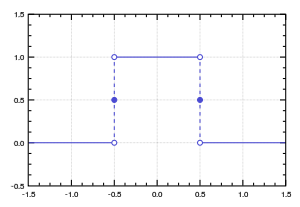Rectangular function

The rectangular function (also known as the rectangle function, rect function, Pi function, gate function, unit pulse, or the normalized boxcar function) is defined as:[1]
Alternative definitions of the function define to be 0,[2] 1,[3][4] or undefined.
Relation to the boxcar function
The rectangular function is a special case of the more general boxcar function:
Where u is the Heaviside function; the function is centered at X and has duration Y, from X-Y/2 to X+Y/2.
Another example is this: rect((t - (T/2)) / T ) goes from 0 to T, so in terms of Heaviside function u(t) - u((t-T) / T )
Fourier transform of the rectangular function
The unitary Fourier transforms of the rectangular function are[1]
using ordinary frequency f, and
.svg.png)
using angular frequency ω, where is the unnormalized form of the sinc function.
Note that as long as the definition of the pulse function is only motivated by the time-domain experience of it, there is no reason to believe that the oscillatory interpretation (i.e. the Fourier transform function) should be intuitive, or directly understood by humans. However, some aspects of the theoretical result may be understood intuitively, finiteness in time domain corresponds to an infinite frequency response. (Vice versa, a finite fourier transform will correspond to infinite time domain response.)
Relation to the triangular function
We can define the triangular function as the convolution of two rectangular functions:
Use in probability
Viewing the rectangular function as a probability density function, it is a special case of the continuous uniform distribution with . The characteristic function is:
and its moment generating function is:
where is the hyperbolic sine function.
Rational approximation
The pulse function may also be expressed as a limit of a rational function:
Demonstration of validity
First, we consider the case where . Notice that the term is always positive for integer . However, and hence approaches zero for large .
It follows that:
Second, we consider the case where . Notice that the term is always positive for integer . However, and hence grows very large for large .
It follows that:
Third, we consider the case where . We may simply substitute in our equation:
We see that it satisfies the definition of the pulse function.
See also
References
- 1 2 Weisstein, Eric W. "Rectangle Function". MathWorld.
- ↑ Wang, Ruye (2012). Introduction to Orthogonal Transforms: With Applications in Data Processing and Analysis. Cambridge University Press. p. 135-136.
- ↑ Tang, K. T. (2007). Mathematical Methods for Engineers and Scientists: Fourier analysis, partial differential equations and variational models. Springer. p. 85.
- ↑ Kumar, A. Anand. Signals and Systems. PHI Learning Pvt. Ltd. p. 258-260.